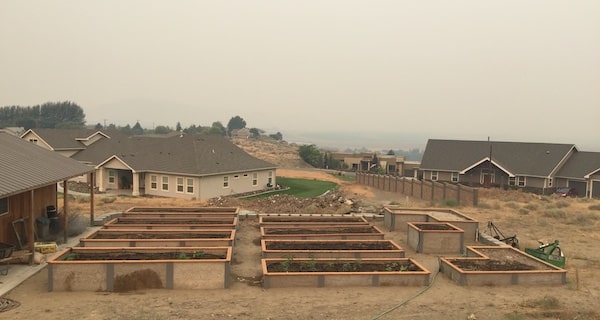Diana Love and her husband, Ed, got a bit of sticker shock when they priced out having a landscape designer excavate and install garden beds for them. It was exorbitant. They knew it would be a challenging project because they live on a steep hill, but the more-than-$30,000 price was a bit too much all around, even for 11 beds.
They both have busy careers, so the idea of excavating themselves and building a retaining wall so they could place garden beds on a steep hill was a bit daunting, but that’s exactly what they did!
Looking for Alternatives
Initially, Diana was considering some material for her garden beds that was an alternative to expensive cedar beds. She also wanted a material that would also be durable in their eastern Washington climate, where conditions can be harsh. “We get a lot of wind,” she notes. “Our winters are typically very cold and can include snow. And because we live on the backside of a hill, we’re also very exposed to sun.” Diana also knew she would need to keep out the ever-hungry rabbits, which are populous in her area.
“I wanted something that I could install once and then not have to worry about it. I don’t want to have to redo these things every five years or so!” she says with a laugh. “I went looking. I searched on google and discovered the Durable GreenBeds website so I checked them out.” She thought they looked “pretty cool,” because they were made by recycling wood chips mixed with concrete to make a strong composite material. She also liked that it came as a kit, because that was something she and Ed could install themselves.
Although Ed isn’t a gardener, he understood the appeal and the ease. He appreciated the prospect of durable garden bed kits that don’t need to be replaced, and that they could install themselves. “He checked it out and he agreed that it would be feasible for our location and also that it looked like something that would hold up well, given our conditions,” Diana says.
11 Garden Beds
The couple purchased 11 beds last summer. They began slowly installing them, after being somewhat stymied by hot temperatures and wildfire smoke. They have two rows of the 12-foot beds with one row of the 1-foot-tall beds and the other row the 2-foot-tall beds. She has two L-shaped beds, one a 2-foot and one a 1-foot, along with a 4×4, 2-foot-tall square that sits between the L-shaped beds. She was able to start her plants from seed this year, and plant in earnest. She’s enjoying harvests of zucchini, Korean melon, a bunch of different peppers, heirloom tomatoes, and pumpkins — although some might not ripen in time this year. Radishes, beets, carrots, spinach, and lettuce also have their own spots. A discussion with a Persian coworker resulted in Diana planting a few varieties of fava beans to see how they do. She may even expand her beds in the future to make room for blueberries and other perennials. “I’ve got quite a bit out there!” she says. “What I got in has been growing really nicely in those beds. It seems to provide a really good environment for the plants.”
So far, she’s noticed that the rabbits aren’t too bad this year, so she hasn’t done anything to protect the plants from them. Each year is different so next year she may need to take a firmer stand to keep the critters out. She and Ed both felt the Durable GardenBed kits were easy to put together. One drawback is that there is one wooden piece made from cedar that caps the frames of the beds. Due to their harsh sun, that wood is already drying out and weathering, so Diana is applying linseed oil to it. Imagine if the whole bed frame was made out of wood!
Learning To Garden Again
Diana says it’s been 20 years since she gardened regularly. She’s enjoying re-learning what she forgot and comparing notes with her coworkers who are avid gardeners. Diana’s planning to retire in the future. Having these beds installed now means her garden will be ready and waiting for her. She won’t have to replace the garden beds again within that time, so she’ll has more free time. Plus, since she chose Durable GreenBeds which are so durable they can last over 20-25 years, she won’t have to deal with replacing her garden beds on a steep hill ever again.
